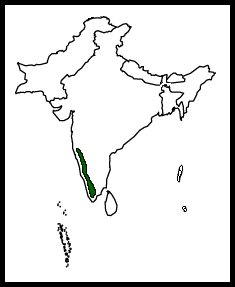Alternative name: Wynaad Laughingthrush
- Pterorhinus delesserti
Dryonastes delesserti
Garrulax delesserti
Ianthocincla delesserti
Identification
With 23 to 26cm a medium-sized Laughingthrush
- Crown, rear supercilium area and mantle dark slaty grey
- Scapulars, back, uperwing-coverts and tertial chestnut-brown, going to rich rufous on uppertail coverts
- Brownish-black tail
- Primaries with dull pale olive-grey fringes
- Face glossy blackish
- Chin and throat white, going to pale grey on breast and orange-rufous on mid-belly to rich rufous on lower flanks
Other Laughingthrushes in range (see genus Montecincla) are quite different.
Distribution
| Endemic to the Western Ghats in SW India. Found from Goa and Belgaum south to Kerala and western Tamil Nadu. Restricted range species. Not uncommon in most parts of its range but hard to see. Present in different protected areas like Thattekad, Mudumalai or Periyar. | |
| Legend |
Taxonomy
This species is sometimes placed in the genus Ianthocincla or in Dryonastes. Was considered conspecific with Rufous-vented Laughingthrush in the past.
This is a monotypic species[1].
Habitat
Evergreen and semi-evergreen forest, cardamon and throny canebrakes sholas. Mostly found between 450 and 760m, but also recorded up to 1220m.
Behaviour
Diet
Feeds mostly on insects, takes also berries and seeds. Forages on or near the ground in small flocks (6 to 15 birds), often associated with Indian Scimitar Babbler. Skulking and difficult to see.
Breeding
Breeding season from December to September, presumed to be a co-operative breeder. The nest is a small cup, almost a semi-dome made of grass, leaves, weed stems, tiwgs and roots, usually placed 2m of ground in a bush or understorey vegetation.
Movements
Resident, no movement known.
References
- Clements, J. F., T. S. Schulenberg, M. J. Iliff, S. M. Billerman, T. A. Fredericks, B. L. Sullivan, and C. L. Wood. 2019. The eBird/Clements Checklist of Birds of the World: v2019. Downloaded from http://www.birds.cornell.edu/clementschecklist/download/
- Rasmussen, P.C. and Anderton, J.C. 2005. Birds of South Asia. The Ripley Guide. Washington D.C. and Barcelona: Smithsonian Institution and Lynx Editions. ISBN 84-87334-67-9
- Grimmett, R., Inskipp, C. and Inskipp, T. 1998. Birds of the Indian Subcontinent. London: Christopher Helm. ISBN 0-7136-4004-9
- Kazmierczak, K. and van Perlo, B. 2000. A Field Guide to the Birds of the Indian Subcontinent. London: Pica Press. ISBN 0-300-07921-4
- del Hoyo, J., Elliott, A. and Christie, D.A. eds. 2007. Handbook of the Birds of the World. Vol. 12. Picahartes to Tits and Chickadees. Barcelona: Lynx Edicions. ISBN 84-87334-30X
Recommended Citation
- BirdForum Opus contributors. (2024) Wayanad Laughingthrush. In: BirdForum, the forum for wild birds and birding. Retrieved 25 April 2024 from https://www.birdforum.net/opus/Wayanad_Laughingthrush





